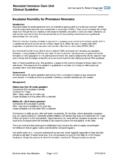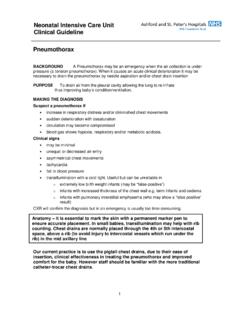Transcription of Neonatal Intensive Care Unit Clinical Guideline …
1 Neonatal Intensive Care Unit Clinical Guideline Nasal High flow for respiratory support ( vapotherm precision Flow). Background: Nasal High Flow (nHF) refers to the delivery of humidified heated and blended oxygen/air at flow rates greater than 1L/min via nasal cannula. nHF can be used for Non-invasive ventilation of extremely preterm / preterm infants Non-invasive ventilation for infants with parenchymal lung disease (HMD/pneumonia/CLD/ MAS/ pulmonary hypoplasia/ bronchiolitis). Treatment/prevention of apnoea of prematurity This Guideline describes our experience and use of the vapotherm precision with a low flow cartridge installed (range 1-8 L/min) to deliver non-invasive ventilation (NIV) from extremely preterm to term infants. We have used this for several years, and it is our routine first line tool for non-invasive ventilation.
2 Our standard policy is to extubate most preterm babies within an hour or two of birth if possible, regardless of gestational age depending on condition. Below 600g BW however NIV is more frequently unsuccessful and it can be difficult to predict which babies can avoid prolonged invasive ventilation. Our aim, as always, is to use the least invasive support possible to achieve stabilisation and minimise adverse outcomes. How does HF work? The mechanisms of how nHF works are multiple and probably have differential contributions at different gestations and disease cycles. Flush is an important and novel concept, and flush is improved by having small nasal prongs to allow leak. This also means that we never use chin-straps etc as flush relies on the flow of gas escaping!
3 Gas conditioning the evidence is that unconditioned ( gas that is not fully humidified or at 37 degrees) causes adverse compliance changes in lung tissue nHF provides some PEEP the evidence is that nHF gives about 4-5 cm H2O (Pharyngeal pressure) up to 8 L/min. However it is not a CPAP device, and we are not controlling nor weaning PEEP. How does CPAP compare? Reduced work of breathing through chest wall stabilisation, preservation of surfactant, reduction of atelectasis etc Some babies seem to be more stable at high mean airway pressures (8-10cm H2O measured at the nares), although there is limited evidence that this is transmitted at alveolar level. Stabilisation / opening at a larger airway level. PEEP may improve gas exchange at alveolar level Other mechanisms may involve stimulation of nasal mucosa.
4 Work of breathing may also be reduced by humidification of gases, a particular feature of nHF. delivery. There is no difference in the work of breathing between CPAP and nHF. vapotherm in NICU Oct 2014 Page 1 of 5 01/10/2014. There is some evidence that synchronised BiPAP (SnIPPV) use in infants at greatest risk of BPD or death (500-750 g) was associated with decreased BPD, BPD/death, neurodevelopmental impairment and death when compared with infants managed with NCPAP. Our experience of successful use of vapotherm in extremely preterm babies is considerable and we routinely manage babies of 500-600. grams upwards using nHF. Benefits include Babies on nHF appear to be well settled and more comfortable than babies on CPAP. Less abdominal gaseous distension than CPAP.
5 Babies do not require time off for nose breaks or changes between nasal prongs / masks, reducing the amount of handling. Some evidence for better weight gain and improved feed tolerance. Parents have reported preferring being able to see more of their babies face. Easier access for cranial ultrasound scans and head circumference measurements. When to use vapotherm for non-invasive ventilation: The recent trials data (Manley/Collins/Yoder etc.) show that nHF and CPAP have very similar overall outcomes. Therefore any baby can be considered suitable for nHF treatment, at any age/gestation, provided they are breathing, do not have congenital abnormalities that make nHF impossible to administer and are not likely to require imminent mechanical ventilation. We no longer withhold nHF if a baby is from another NICU/SCBU that does not have nHF on the basis that we wish to offer the best treatment, in the judgement of the clinician, to all babies regardless and also that the number of units using nHF is increasing all the time all Surrey and Sussex SCBU now have at least one nHF unit.
6 When to decide vapotherm is not providing sufficient support : Recurrent / persistent apnoeas Increasing FiO2. Increasing work of breathing Increasing pCO2 / TcCO2 causing acidosis may indicate that the baby is not responding well to vapotherm treatment. Unless intubation and ventilation is required, it is suggested that sNIPPV (BiPAP with trigger) is used as a more aggressive technique of non-invasive ventilation. However babies who are becoming apnoeic due to sepsis etc, will require ventilation and the clinician should not automatically elevate to sNIPPV as intubation may be more appropriate Our experience is that many babies escalated to BiPAP progress to full ventilation. The failure rate is no worse with nHF than with nCPAP and may be better. MIST (Minimally Invasive Surfactant Treatment) can be carried out with a baby on nHF with ease.
7 vapotherm in NICU Oct 2014 Page 2 of 5 01/10/2014. Setting up the vapotherm for nHF: Wait for desired operating temperature to be reached before placing the cannula on the end of the patient delivery system: Set at 37oC for all flows unless in an open cot, where condensation may become an issue at flows <4l/min. Attach appropriate sized nasal cannula. Cannula should ideally not obstruct or be larger than the diameter of the nares. Weight Cannula type < kg Premature - Neonatal kg > kg Infant Adjust the flow to the desired rate and place the cannula on the patient. Operational flow rates range from 1-8 L/min Start at flow rate of 7-8 L/min in preterm babies Increasing flow (maximum 8L/min): flow can be increased in increments of L/min to try to treat increasing oxygen requirements or apnoea of prematurity.
8 However other causes (sepsis, worsening RDS, pneumothorax, exhaustion etc should be considered). If the baby is requiring FiO2 >60%, or has significant persisting respiratory acidosis (pH< ). or apnoea s/he is likely to need alternative support . Nursing: o Minimal handling, quiet and dark appropriately humidified (see Guideline ) environment o Monitoring of heart rate, respiratory rate and SaO2 as a minimum o Transcutaneous pCO2 monitoring is very useful o Blood pressure monitoring intermittently unless UAC/arterial line in place o Prone position, tilted head up to minimise work of breathing o Orogastric tube preferred initially at least. Nasogastric tube should ensure that nostril not occluded and than tube does not pull' nares towards cheek. Medical checks: o Blood gases are indicated if on supplemental oxygen or on Clinical grounds.
9 A stable baby in air does not require blood gases to be checked from a respiratory perspective o Coordinate examinations, blood tests and procedures with nursing care to minimise handling vapotherm in NICU Oct 2014 Page 3 of 5 01/10/2014. Weaning a baby on vapotherm : The purpose of weaning is to find the minimum required level of support and this process should begin once the baby is stable. This is a Clinical decision. Weaning can begin when the baby is stable, which may take hours or days. Term Babies and ex-preterms > weaning More proactive weaning should be attempted, aiming to see if the baby will tolerate a reduction towards about 3 L/min which would permit switching off or to low-flow/ambient support . The table below provides a guide to weaning thresholds.
10 Weaning strategy for Term babies / Ex-preterms > FiO2< FiO2 FiO2 > Reduce by 1 L/min Reduce by Weaning <4L/min usually 24-48 hourly 24 hourly not indicated depending on stability Preterm Babies weaning For babies < kg Babies on flow rates > 6L/min should have these re-evaluated regularly (minimum daily). Preterm infants are at high risk of pneumothorax, RDS and IVH in the first few days postnatally, and stability during that time is particularly crucial For a stable babies, it is suggested that clinicians attempt to wean according to the criteria below until the flow rate is about 4-6 L/min Once the baby is settled in the target range of 4-6L/min we often do not aggressively wean the respiratory support further, unless the baby is in air. Instead, we concentrate on achieving growth and stability, using the vapotherm to minimise energy expenditure on breathing.






